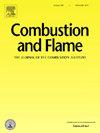Fuel injection dynamics transition from two-phase theory to single-phase dense fluid dynamics are a crucial phenomenon that markedly affects the mixing process and subsequent combustion under diesel engine-relevant conditions. As the significant effect of fuel properties on the timescale and mechanism of this transition remains elusive yet, this work focuses on the impact of fuel properties on the transition to single-phase dense fluid at supercritical pressure. The detailed thermodynamic structure of non-continuum gas-liquid interfaces at supercritical pressures was constructed through gradient theory, and its evolution was analyzed. The driving mechanism of transition from spray to single-phase dense fluid was discussed. The influences of fuel properties on the timescale and mechanism of breakdown of the two-phase theory were investigated through the comparison of three different alkanes. Theoretical analysis suggests that the transition from spray to single-phase dense fluid is jointly promoted by the thickening interface, the diminished surface tension, and the shorter molecular mean free path. The gas-liquid interface of lighter-alkane/nitrogen binary systems is more inclined to evolve into the continuum length-scale regime. The cause is a combination of two aspects: (1) smaller thermodynamic potential energy density difference and smaller interfacial tangential pressure across lighter alkanes/nitrogen interfaces lead to broader interfaces and smaller surface tension, (2) the more volatile nature of lighter alkanes results in shorter molecular mean free path. The minimum reduced pressure required for gas-liquid interfaces to reach critical mixing states is lower for lighter and more volatile alkanes at the same reduced temperature. From a time-scale perspective, the non-continuum gas-liquid interfaces evolve into the continuum length scale regime later for heavier alkanes. This suggests that the transition to the diffusive mixing mechanism occurs further downstream for heavier alkane sprays. A conceptual diagram was presented to illustrate the effect of fuel properties on the transition.


